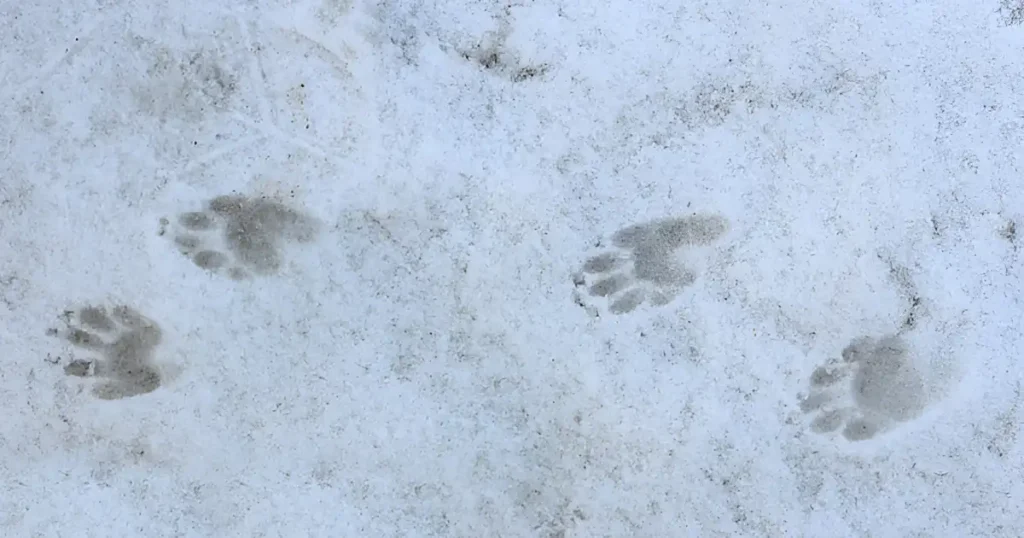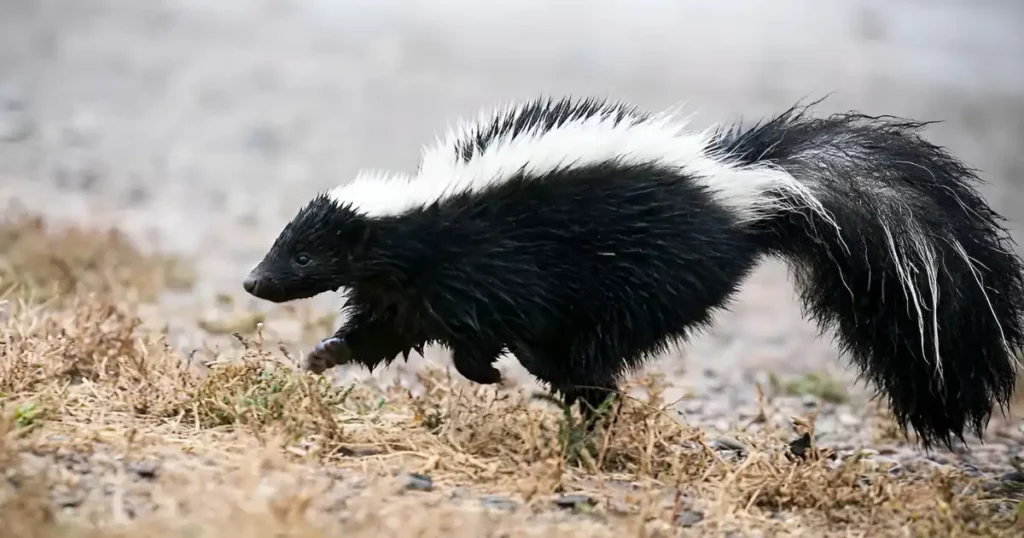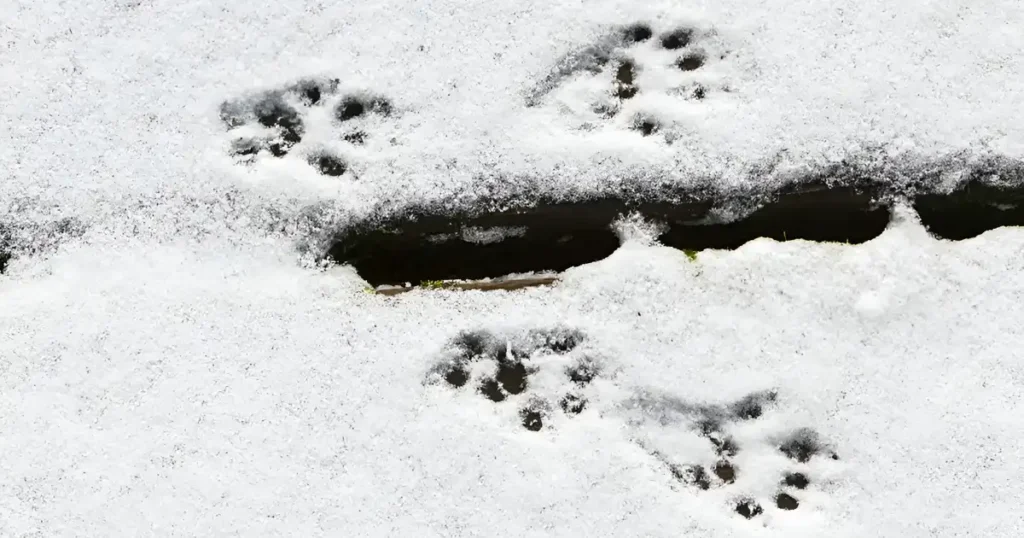
Skunk tracks are an important indicator of the presence of skunks in a particular area. These tracks can be found in a variety of habitats, including forests, fields, and suburban areas. Skunk tracks are unique in that they often show a distinct pattern of five toes with sharp claws and a distinct heel pad that is often heart-shaped.
Skunk tracks can be used to identify the species of skunk that made them. For example, striped skunk tracks are usually larger than those of spotted skunks, and they often show a more pronounced heel pad. In addition, striped skunk tracks tend to be more widely spaced than those of spotted skunks, which have a more narrow gait. By examining the size and shape of skunk tracks, researchers can gain valuable insights into the behavior and distribution of these animals.
Despite their distinctive appearance, skunk tracks can be difficult to spot in certain environments. In areas with thick vegetation or soft soil, tracks may be obscured or quickly erased by natural processes. However, if you watch carefully and have a bit of luck, you can find and identify skunk tracks in the wild.
Skunks are known for their distinctive black and white striped fur, but they also leave behind unique tracks that can help identify their presence in an area. Here are some tips for identifying skunk tracks in different types of terrain.

Skunk tracks in snow can be easily identified by their distinct pattern. Skunk tracks are usually around 2 inches in length and have five toes on each foot. The toes are spread out and the front toes are longer than the back toes. The tracks are usually in a straight line, with the back foot landing in the same spot where the front foot was lifted. The tracks may also have drag marks from the skunk's tail.
Skunk tracks in mud can be a bit harder to identify, as they may appear more like small paw prints. However, skunk tracks in mud still have the five-toe pattern, with the front toes being longer than the back toes. The tracks may also have drag marks from the skunk's tail.
Striped skunk tracks are the most common type of skunk tracks found in North America. They have the distinctive five-toe pattern and are usually around 2 inches in length. The tracks are usually in a straight line, with the back foot landing in the same spot where the front foot was lifted. The tracks may also have drag marks from the skunk's tail.
Overall, skunk tracks can be a useful way to identify the presence of skunks in an area. By paying attention to the distinctive five-toe pattern and drag marks from the skunk's tail, it is possible to determine whether skunks are active in the area.
Skunks are omnivores and their diet can vary depending on the season and availability of food. They are known to have a preference for insects, but they will also eat small mammals, fruits, and vegetables. Skunks are nocturnal animals and are most active during the night when they forage for food. They locate their prey with their acute sense of smell. Skunks have long claws that they use to dig for insects and other food sources.
Skunks are active throughout the year, but their behavior changes depending on the season. During the winter months, skunks tend to be less active and will spend more time in their dens. They may also enter a state of torpor, which is similar to hibernation, to conserve energy. In the spring, skunks become more active as they search for food and mates. This is also the time when they may spray their musk as a defense mechanism. During the summer months, skunks are most active and are often spotted while foraging for food in the nighttime. In the fall, skunks will begin to prepare for the winter months by storing food and finding a warm den to hibernate in.
Skunks are generally solitary animals, but they may form small groups during the mating season. They also will mark their domain with their musk as they are territorial. Skunks are not aggressive animals, but they will defend themselves if they feel threatened. Giving skunks their space and avoiding approaching them is important. If you do encounter a skunk, it is best to slowly back away and give them an escape route.

Skunks are found throughout North America and prefer habitats that provide an ample supply of food, water, and cover. Because of their adaptability, they can survive in a range of settings, such as suburban areas, grasslands, and woodlands. Skunks are also known to den in abandoned burrows, hollow logs, and rock crevices.
Skunks are most active at sunrise and sunset and can be attracted to human food and garbage. Taking proper care in disposing of any food waste and avoiding leaving food out in the open is important. Skunks are also known for their defensive spray, which can cause temporary blindness and a strong odor. Avoid startling or provoking skunks to prevent any unwanted encounters.
Overall, skunks are an important part of the ecosystem and play a key role in controlling rodent and insect populations.

Because of their adaptability, skunks can survive in a range of settings, such as suburban areas, grasslands, and woodlands. However, habitat fragmentation and loss due to human actions such as urbanization, agriculture, and logging are major threats to their survival. Therefore, habitat protection is crucial for the conservation of skunk populations.
The creation of protected places, such as national parks and wildlife reserves, as well as the application of land-use regulations that support sustainable development, are two strategies used to preserve skunk habitats. In addition, conservation organizations work with landowners to promote habitat conservation on private lands.
Wildlife corridors are strips of land that connect fragmented habitats, allowing animals to move between them. They are important for maintaining genetic diversity and promoting the survival of species, including skunks.
Conservation organizations are working to establish wildlife corridors for skunks and other wildlife. This involves identifying areas where corridors are needed, negotiating with landowners to secure land for corridors, and implementing measures to ensure that the corridors are effective in connecting habitats.
Overall, conservation efforts for skunks are important for their survival and the maintenance of healthy ecosystems. By protecting their habitats and establishing wildlife corridors, we can ensure that skunks continue to play their important role in the natural world.

Skunks are generally non-aggressive animals, but they can spray a foul-smelling liquid when they feel threatened. To avoid encountering skunks, it is best to keep a safe distance and avoid startling them. If you see a skunk, move away slowly and quietly.
Additionally, it is important to keep your property clean and clear of possible nutrition sources, like trash or pet food. Skunks are attracted to these items and may come searching for food inside your property.
If you come across skunk tracks, it is important to take precautions to avoid any potential encounters. Wear gloves and avoid touching the tracks directly, as diseases such as rabies can be carried by skunks.
It is also important to note that skunk tracks may be a sign of a bigger concern, such as a skunk den on your property. In this case, it is best to contact a professional wildlife removal service to safely and humanely remove the skunks.
By following these safety and prevention tips, you can avoid potential encounters with skunks and keep your property free of these unwanted visitors.
Have you spotted skunk tracks and/or other signs of skunks near your property? We at Critter Stop know exactly how to deal with them! We are an experienced professional wildlife removal company servicing commercial and residential customers in Texas. We have a five-star reputation, offer industry-leading guarantees, and are fully licensed and insured. Contact Us at (214) 234-2616 and book your free inspection and estimate today!
Skunk tracks typically have five toes on each foot, with the front and hind tracks appearing almost identical. The prints are about 2 to 2.5 inches long and 1.5 to 2 inches wide. Skunks have long claws, which are usually visible in the tracks. The tracks are often in a straight line, with the hind prints slightly overlapping the front prints.
Skunk tracks and raccoon tracks are similar in size and shape, but there are some differences. Skunk tracks have five toes on each foot, while raccoon tracks have five toes on their front feet and four toes on their hind feet. Skunk tracks also tend to be more symmetrical than raccoon tracks, which are often lopsided.
Skunk tracks and cat tracks can be similar in size, but there are some key differences. Skunk tracks have five toes on each foot, while cat tracks have four toes on their front feet and four toes on their hind feet. Skunk tracks also have longer claws than cat tracks.
In dirt, skunk tracks will be more defined and have more detail than in snow. In snow, the tracks may appear more rounded and less distinct. However, skunk tracks in snow may be easier to follow because they are more visible.
Skunks tend to walk in a straight line, with their hind feet slightly overlapping their front feet. Skunks also tend to move at a slow pace, so their tracks may be close together and appear as if they are shuffling along.
Striped skunk tracks are similar to other skunk tracks, but they often have a distinctive pattern. The tracks may appear as a series of dots or dashes, with the hind tracks slightly overlapping the front tracks. The tracks may also have a wavy pattern, which is caused by the skunk's waddling gait.
Visit our Critter Library and learn more about our furry friends